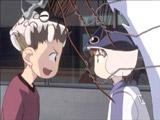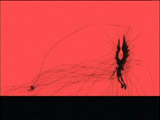

Quick Links:
Alien Nine
"My last year of elementary school, and it SUCKS." These are the first words uttered by Yuri Otori, the leading player in this story. Yuri has her reasons for her dismal outlook of the school year, though. She has just been almost unanimously elected to the "Alien Party" of her school. The Alien Party is a special branch of each school that has to neutralize and capture the various alien threats that appear on the school grounds. Naturally, a normal school girl wouldn't be too happy with this duty, especially since members of the Alien Party are also required to wear symbiotic aliens on their heads. When she gets to the Alien party room, she finds the facility nearly deserted. The three that actually are there are Kasumi Tomine, Kumi Kawamura, and Alien Party Instructor Megumi Hisakawa. Kumi is a popular girl that was class president every year from grade one. She joined the Alien Party, since she thought it would allow her to escape the stress and responsibilities of being class president. Kasumi is the daughter of a wealthy family and has a constantly cheery demeanor. She joined the Alien Party since she thought it would be "fun". After basic introductions, and detailing the girls' duties, Megumi gives the girls their aliens, also known as Borg. From that point on, the girls are charged with joining together to stop the alien menace that constantly threatens their school.
While the basic storyline sounds bland overall, it is almost impossible to capture the spirit of the show in just words. It is impossible to capture Yuri's melancholy reluctance, or Kasumi's constant, almost disturbing, cheerful demeanor. The story itself may sound a bit weak, but it is anything but. The characters are quite possibly the most realistic I have seen in an anime series to date. For example, Yuri, while seemingly a childish character that is prone to crying, has more to her than circumstances may hint at. In truth, Yuri is actually a member of a family with unsupportive parents that push her to do things she does not want to do. Therefore, she has a very low self-image and cannot deal with pressure as well as most people. The characters do not try to hide their personalities, a la Evangelion, nor do they all have a strange psychological disorder. They just have everyday problems, such as lonliness, or being forced to change too much too quickly. The characters evolve greatly over the course of the four-episode series, as they all change in their own subtle ways. If there were a flaw, however, it would be the ending. Since the series is only four episodes long, it ends very abruptly. There is no real ending since the manga series is still ongoing. This is easily offset by the fact that the OVA is directly continued in the manga. Because of this, the rest story can still be enjoyed without sacrifice, or need for a "draw your own conclusions" situation.
If I were to describe Alien Nine's animation in two words, I would have to use "beautiful" and "amazing". The series displays an excellent mesh of cel-based and computer generated animation. While I usually have qualms with the mixture of CG and animation, the two fit beautifully together, with no overly noticeable moments that would make the series seem out of place. Actually, the use of CG is rather limited overall to key moments with the Borg, and one to two other isolated instances. The cel animation is nothing short of excellent, with fluid movement for both the characters and the aliens. There are a few skipped frames in high-speed scenes, but there is nothing that would make the characters seem jerky or stiff. Overall, Alien Nine displays impressive animation that can beat even a few current theatrical works.
The series' music holds the same outstanding quality other aspects of the series hold. The opening theme, "Flower Psychadelic," starts off dark and brooding, but quickly escalates into a lighthearted and cheerful melody that perfectly captures the main characters. Through the show, the music changes to mirror the situations that are occurring. From the lilting recorder flutes and children's choir of the show's lighter moments, to the slower, more deliberate pace of the show's sadder themes, there is a tune for every occasion. The theme that plays in the end credits is a slower, more somber tune compared to the opening, but it captures the end of the series very well, hinting at things to come in the latter part of the series. The two together make an excellent pair, with one complementing the other and neither being too overpowering for the series itself. The music itself is a treat for the ears that accomplishes its duty with flying colors.
On the voice acting front, the dub track is good, but does not quite capture the essence of the show itself. The cast itself is made up of a few of the best in the business, but none of them even touch the top role in this series: the voice of Yuri Otani. A rookie to the voice acting scene, Kelly Ray put out an excellent performance in her portrayal of Yuri. To support Ms. Ray, veterans Angora Deb, Rachel Lillis, Tristan Goddard, and Veronica Taylor round out the cast with their usual fare in acting. However, none of the English cast compare to the original Japanese cast, who put out a stellar performance as usual. I found no problems with the subtitles such as grammar mistakes or errors in translation. Although I prefer the Japanese track by far, the English track is still worth checking out.
Alien Nine is available on exclusively on Central Park Media's "Collector's Series" DVD label. The packaging features an action shot of the three main characters on the front decked out in their "Alien Party" gear with the school in the background. The back of the case features a brief description of the series itself, along with a description of the DVD features. Along with this is a shot of the three girls, once again in their "Alien Party" gear, sitting on a desk. In their usual fashion, Central Park has opted to go with a clear keepcase. Inside the keepcase, all of the chapter stops, casting information, and DVD credits are printed on the opposite side of the cover along with a piece of color artwork. The insert is an advertisement for Central Park's "Anime 101" line of DVDs.
On the extras front, Central Park has managed to stuff quite a bit of material into this disc. The art gallery is a slideshow of conceptual art and promotional materials, as well as a few screens from the series itself. The sketch gallery is a collection of promotional sketches that were used in the creation of the show that range from characters to aliens. The dubbing diary is a fun bonus for dub fans, or those interested in the dubbing process, as it outlines the process of the show's dub and contains interviews with several of the voice actors. Also included is a collection of eight commercials for the series that aired on Japanese television. The honor of top extra, however, is awarded to a full interview with the series' producer, Taro Maki. The list of extras is rounded out with a collection of trailers for the Alien Nine OVA series and manga. Also included is a set of DVD-ROM features that includes downloadable versions of the sketch/art galleries and a full script for the series.
Looks definitely are deciving with Alien Nine. The cute exterior hides an amazingly deep show that will touch viewers on many levels. All of the individual elements manage to blend together perfectly to create a modern masterpiece that no self-respecting anime fan should pass up.
Distributor: Central Park Media Creator: Hitoshi Tomizawa / Genco Released: 2001
Plot: A Character Design: A- Animation Quality: A- Music: A Overall: A



